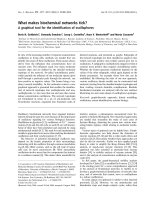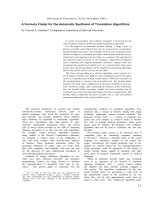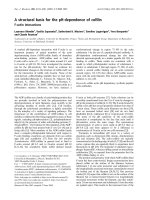developing a marketing plan for the keywordz service of gapit communication joint-stock company
Bạn đang xem bản rút gọn của tài liệu. Xem và tải ngay bản đầy đủ của tài liệu tại đây (1.63 MB, 87 trang )
VIETNAM NATIONAL UNIVERSITY, HANOI
SCHOOL OF BUSINESS
TRAN THI THUY
DEVELOPING A MARKETING PLAN FOR THE
KEYWORDZ SERVICE OF GAPIT COMMUNICATION
JOINT-STOCK COMPANY
MASTER OF BUSINESS ADMINISTRATION THESIS
Hanoi - 2011
VIETNAM NATIONAL UNIVERSITY, HANOI
SCHOOL OF BUSINESS
TRAN THI THUY
DEVELOPING A MARKETING PLAN FOR THE
KEYWORDZ SERVICE OF GAPIT COMMUNICATION
JOINT-STOCK COMPANY
Major: Business Administration
Code: 60 34 05
MASTER OF BUSINESS ADMINISTRATION THESIS
Supervisor: Ph.D: Tran Doan Kim
Hanoi-2011
vi
TABLE OF CONTENT
ACKNOWLEDGMENT i
ABSTRACT ii
TÓM TẮT iv
TABLE OF CONTENT vi
LISTS OF TABLES ix
LIST OF GRAPHS x
INTRODUCTION 1
1. Necessity of The Thesis 1
2. Research Aims and Purposes 2
3. Research Scope 2
4. Data sources and Processing 2
5. Methodology 3
6. Limitations of the Thesis 3
7. Expected finding 3
CHAPTER 1: LITERATURE REVIEW 4
1.1. Marketing plan 4
1.1.1 Marketing plan definition 4
1.1.2 Process to formulate Marketing plan 5
1.2 Mobile marketing 15
1.2.1 Mobile marketing definition 15
1.2.2 Mobile marketing solution 18
vii
1.3 Special considerations for a marketing plan of a Mobile marketing
service 23
CHAPTER 2: GAPIT COMMUNICATION AND KEYWORDZ SERVICE
SITUATION ANALYSIS 26
2.1 Introduction Gapit JSC and Keywordz 26
2.1.1 Background of Gapit communication 26
2.1.2 Gapit keywordz 28
2.2 Marketing situation analysis 31
2.2.1 Keywordz market and customer analysis 31
2.2.2. Competitors analysis 35
2.2.3 Partners 40
2.2.4 Environment: PEST analysis 40
2.3 Opportunities and issues analysis 42
2.3.1. SWOT analysis 42
2.3.2. Analysis of marketing issues for the Keywordz services 47
CHAPTER 3: SET UP MARKETING PLAN TO GAPIT KEYWORDZ
SERVICE 48
3.1 Marketing objective 48
3.2 Marketing strategies 48
3.2.1 Market segmentation and selecting target market 49
3.2.2 Product positioning 50
3.2.3 Recommending a marketing strategy for the Keywordz service
53
viii
3.2.4 Keywordz service 54
3.2.5 Price 55
3.2.6 Place 56
3.2.7. Promotion 57
3.2.8. People 61
3.2.9. Process 62
3.2.10. Physical evidence 64
3.3 Action plan 64
3.4 Expected turnover and loss 72
3.5 Control 74
CONCLUSION 75
REFERENCE 76
APPENDIX 77
ix
LISTS OF TABLES
Table 1.1 Bluetooth Content 19
Table 1.2 Type of Coupon 20
Table 2.1: Characteristics of SWOT of Gapit Keywordz service 42
Table 3.1: Description the action plan 66
Table 3.2: Estimated Cost 72
Table 3.3. Estimated Profit & Loss account 73
x
LIST OF GRAPHS
Graph.2.1: The data on mobile subscribers in 2006, 2007, 2008, 2009
year……………………………………………………………… ………….32
Graph 2.2: The turnover of digital mobile content service………………. 33
Graph 2.3: The main download content in Mobile phone 45
Graph 2.4: The operating subscribers up to 6/2008 45
Grap 3.1: Positioning chart of Gapit keywordz and direct competitors 51
Graph 3.2: Process to supply Gapit keywordz service: 62
Graph 3.3: Process to implement Mobile maketing 63
1
INTRODUCTION
1. Necessity of The Thesis
Founded at the first time in American in 2004, up to now, the definition of Mobile
marketing has not been new thing in the world because a half of decade recently,
Mobile marketing is effective real tool to many service, food product, fashion
firms…to promote their products and brand name.
According to statistic of Yakee, now there are more 2.5 billion people use mobile
phone in the world, more 90% of them have send or receive message demand, not
only call and answer. Mobile phone is the nearest medium beside owner in 24 hours
in all days of week, more permanently than any means of transportation included
Internet and Television. Catch up this demand; companies exploit value added
service on mobile phone launch new application is Mobile marketing. This marketing
channel is exploited successfully in Europeans countries, America, South of America,
and many countries in Asia. Immediately, Mobile marketing have attracted attentions
of many advertisers and prestigious corporations as Wheat Crunchies (Golden
wonder) fast food, Dunkin Donuts café (Italy), or marketing campaign of Sony
Ericson, Nokia, LG…
Mobile marketing is step-by-step gaining foothold in the advertising field. Mobile
marketing is a growing two-way marketing medium that is already today cost-
effective and more importantly, interactive channel that can be utilized to drive the
sales of myriad products and services.
Now, advertisers, firms, can approach this online Mobile marketing solution, the first
appear in Vietnam named Gapit Keywordz by Gapit Communication JSC developing.
This solution is combine between E-commerce and M-comerce, bring to useful of the
most favorite commerce both forms.
The different point in this solution is only through website www.keywordz.vn,
individuals, enterprises can implement buy code process fast, create online
2
marketing scenario simply, manage and update online customers’ database, and
analyze customers’ database optimally through online report.
This product launched in to market from 27/3/2008. After four mounths, the account
registered number is 400; the total access to website/mounth is about 7.000 people;
the SMS number send via system is 77.637 SMS (Vietnamnet.vn)
From the meaning of application Mobile marketing in companies’ marketing
campaign, author decides study Mobile marketing and choice topic “Developing a
Marketing plan for the Keywordz service of Gapit Communication Joint Stock
Company” to study and write my MBA thesis.
2. Research Aims and Purposes
Based on reasons above, the purpose of this study is to gain a better understanding
of Mobile marketing, how organization do plan Mobile marketing and epecially writing
a Mobile marketing plan for Gapit Keywordz in next year 2012.
In order to reach the research purpose for this study the following research questions
are stated:
1. What is Mobile marketing and other related definitions to Mobile marketing?
2. How is application of Mobile marketing in Vietnam?
3. What are steps in building marketing plan for Mobile marketing service for
Gapit JSC?
3. Research Scope
The scope of study is Mobile marketing and how to plan Mobile marketing campaign.
The research scope is also in Gapit Communication Technology JSC.
4. Data sources and Processing
The data sources is used in the Thesis is colected by many sources, from Internet;
newspapers; VMA and MMA Mobile marketing documents; Gapit’s financial report
2006, 2007; International Conferrence on Digital Marketing documents. They are
colected and analyzed, used as secondary data. In addition, informations about Gapit
3
in my thesis is experienced after I worked for Keywordz department as Asistant,
product and contract management.
5. Methodology
Analysis and Generalization : The information in the thesis was analyed and created
by a number of documents and records of electronic marketing, digital marketing,
concepts and ideas of planned digital marketing, mobile marketing. In addition, the
research conducted with data from company, digital conferences, and consulting
experts in the implementation of campaign planned for mobile marketing. These
sources are not only theoretical but also practical.
Survey: In the process, the author has surveyed a number of key customers and
partners of GAPIT Keywordz to find out GAPIT Keywordz’s weaknesses,
opportunities and threats as well as the reasons they use Keywordz of GAPIT
Communication JSC but services of other companies.
Case Studies: the thesis concentrate analysis the case of Gapit Communication JSC,
the mobile marketing service named Keywordz of that company.
6. Limitations of the Thesis
Because E-marketing is very broad and extensive, and due to limited time allocated
for undertaking this research. This thesis will only focus on examining the use of
Mobile marketing and how can develop a mobile marketing plan, to further limit the
research only Gapit Communication JSC and companies implement sucessfully
Mobile marketing of Gapit.
7. Expected finding
The expected findings in study is have an overview of Mobile marketing and Mobile
marketing plan; how companies see the benefit of applying Mobile marketing in
Marketing campaign. And more important thing is complete writing Mobile marketing
plan for Keywordz service of Gapit Communication JSC in 2012.
4
CHAPTER 1: LITERATURE REVIEW
1.1. Marketing plan
1.1.1 Marketing plan definition
Form the Marketing text book, the nature and contents of a marketing plan can be
understand that marketing plan is one of the most important outputs of the
marketing process. It relies very heavily on an analysis of the industry, the business
and the product situation.
1
It is also the instrument for planning and organising the company’s resources and
capacities for achieving marketing objectives for the new firm. It has to identify the
most promising business opportunities for the company and details how to enter,
capture and retain positions in identified markets.
The marketing plan can and should be an essential document for organizational
success. The marketing plan is also an operational document that is created at the
business level of the organization. The plan may address a multiple year time
horizon but it should be reviewed and updated on an annual basis. Plans tend into
one of two categories: a new products/services introduction plan or an annual
marketing plan that addresses products and/or services that already in your
company profile.
1 KoTler, Armstrong, Brown, Adam and Chandler, “ Marketing” ( Fourth
edition) ( Page 72)
5
1.1.2 Process to formulate Marketing plan
Base on William Sahlman of Harvard University in E-marketing book, he identifies
nice questions that every business plan should answer:
2
1. Who is the new venture’s customer?
2. How does the customer make decisions about buying this product or service?
3. To what degree is the product or service a compelling purchase for the
customer?
4. How will the product and service be priced?
5. How will the venture reach all the identified customer segments?
6. How much does it cost (in time and resources) to acquire a customer?
7. How much does it cost to produce and deliver the product and service?
8. How much does it cost to support a customer?
9. How easy is it to retain a customer?
The above questions are also problems that companies should consider when they
decide to formulate any marketing plan.
Based on “Destination Marketing” by Richard B. Gartrell (by Publisher:
Kendall/Hunt Publishing Company in January 1994) Marketing plans may be long or
short, and they will vary among organisations/regions. Whatever their length of
character, marketing plan are valued as a tool for effective planning and assessment
of productivity
To have a successful marketing plan, companies should do enough nine steps. The
following steps are some general guidelines for developing a marketing plan. The
marketing plan details who will do what, when, where and how, in order to achieve
the firm market objectives.
2
Judy Strauss, Adel El- Ansary, Raymond Frost; “E-Marketing book” (Fourth
Edition) (page 48)
6
Product specific, market specific or company-wide plan that describes activities
involved in achieving specific marketing objectives within a set timeframe. A market
plan begins with the identification (through market research) of specific customer
needs and how the firm intends to fulfil them while generating an acceptable level of
return. It generally includes analysis of the current market situation (opportunities and
trends) and detailed action programs, budgets, sales forecasts, strategies, and
projected (pro forma) financial statements.
a) Executive Summary
Executive Summary is brief explanation of what the organization does its mission
statement, the management’s infrastructure, and a short summary about the
marketing objectives and the proposed plan.
Summary is one of the most important parts of the marketing plan. The objective is to
give clear understanding what this marketing plan is about without getting into
details. Although the summary is located under the first chapter, it is usually
completed last after the whole plan is complete.
3
It is typically one to three pages but shorter is better and it is usually written last.
b) Situation Analysis
Situation analysis provides information and brings to better understand about the
current location, the target markets, and competitors in the market.
First, an organisation needs to assess its present situation. This assessment will
explore the realities of the industry, the community, the product or service, the
economic environment and the potential or present customers. This analysis serves as
3
Richard B. Gartrell, “Destination Marketing”, Developing a Marketing plan
7
a platform to support the choice of objectives and strategies.
4
Market Attractiveness analysis: this section should include an analysis of how
big the market is, what competitive forces put pressures on performance levels
in the market and what the future is of relevent trends in the environment
Customer analysis: this section should present an analysis of the factors that
attract and retain cuctomer, to provide the support for customer-oriented
actions. It should include a clear description of the major segments in to which
the organization separates its customers, and an analysis of the effect of
marketing on each segment. The customer segment analysis should include
who they are, what motivate them to buy, what their buying process is, who they
depend on for advice, how often they buy, and how they use the
products/services, etc.
Competitor analysis: this section should present an analysis of key
competitors, defined as any initiative posting a barrier to adoption of your
program. It should summarize their objectives and current strategies, their
strengths and weaknesses on the dimensions that will affect their ability to
compete effectively, and their likely future actions.
c) Objectives and Goals
Marketing Objectives is where the marketing goals and financial objectives are set.
Objectives should be challenging, yet attainable for the organization
The second element in developing a marketing plan is the establishment of
measurable goals. This can be accomplished only after carefully considering the
demand and supply potential of the customers. Questions that address this issue are
4
Richard B. Gartrell, “Destination Marketing”, Developing a Marketing plan
8
as follows:
5
What kind of goals should be established? Should they be short and/or long
term? Is there a baseline against which such goals are being set?
What kinds of markets should be targeted and what are the goals for each
market segment?
How will the organisation assess the attainment of these goals?
Are the goals realistic in terms of the organisation’s resources, timelines and
products?
Not every market opportunity is a business opportunity. Only those market
opportunities that are consistent with the firm’s mission, vision, objectives and current
or potential organization strengths are business opportunities. Therefore, the marketing
plan should present the entire objectives, from those at the corporate strategic level to
those of non-marketing functional areas, as well as for the marketing area itself.
6
d) Market Segments
The third essential element in a marketing plan is that of identifying and selecting the
target markets. This is usually called market segmentation. Market segmentation is
identifying different groups (segments) in a population. It is more beneficial for an
organization to focus its marketing efforts on a group who have similar
characteristics, needs, and wants, than it is to a group of undifferentiated people.
There are many different ways a group can be segmented. The most common
characteristics included: demographic (age, income), psychographic (social class,
lifestyle), and geography. An organization can increase their revenues and decrease
their expenses by focusing their efforts on a market segment.
5
Richard B. Gartrell, “Destination Marketing”, Developing a Marketing plan
6
Judy Strauss, Adel El-Ansary, Raymond Frost, “ E-marketing”
9
Demographic variables most commonly used to identify groups include age, sex,
income, expenditure patterns, occupation, education, household size, marital status
and ethnic background.
Psychographic research (or personality research) goes beyond demographics and
asks why people behave or select products in a certain way. It wants to get at the root
of their decision making process, it wants to find out why some select one product not
another product. Psychographic research can measure which population segments
use this product or service, what motives can be identified to increase their potential to
use.
Geography is another means of defining a market segment; for example, an
organisation may find that it has a potential market for daytime or overnight tours from
group operators within a five-hour drive of that destination. Specific events or activities,
such as antique fairs, cultural events or special pageants may be interest to those tour
operators who have groups that wish to spend only a day away from their homes.
Geographically, this opens a new market segment for an organisation.
To evaluate each market segment and selecting the appropriate segment that will be
profitable. When analyzing a segment there are many factors to consider. The
segment needs to be the right size. A common mistake is large companies marketing
to a small segment. This is probably an unprofitable situation for the company. The
opposite is true with small companies marketing to a segment that is too big. They
simply do not have enough resources to meet the demands of the large segment. A
sure miss when trying to target a market is when a segment is in an environment
where a number of competitors already exist. When selecting a target market an
organization has to consider the different patterns to chose.
e) Marketing Strategies
Marketing Strategy is plan for meeting the marketing objectives.
The fourth element in a marketing plan is that of identifying and selecting the
appropriate and most productive marketing strategies for the targeted market. Based
10
on understanding of both competition and the target, marketers must decide how to
differentiate their products from competitors’ products in a way that provides benefits
perceived as important by the target.
Marketing strategies should be formulated by market segment if possible, to keep
customers foremost. However, concern for production and marketing effiency may also
require that services delivery is coordinated across segment.
According to Philip koler in Marketing management book, a marketing plan strategy
including:
Selecting target market:
Mobile marketing with personal customers is potential rich soil. If do positioning and
make an order well, good idea campaign, company will attract more number of that
loyal customers. For intance, well-khown people as singers, composers, actor or
actress, they can use Mobile marketing application as promotion method when
introduce new album, live show, their music project.
Product positioning: “Positioning is the act of designing the company’s offering and
image to occupy a distinctive place in the target market’s mind”7
This is one of four positioning strategies are promoted largely by advertisers Al Ries
and Jack Trout, including: positioning to solid the current position in customer’s mind,
positioning to vacant market, positioning to reconfirm competitive position or
postioning as different club strategy.
7 Philip Koler – Marketing management, the second edit, page 202, “Positioning
and differentation strategy”
11
According to them, general well-known products have one position in customer’s
mind. For instance, Coca-cola is number one soft drink in the world. Hennessy is
high-grade wine for high-society. Chanel No 5 is high-class perfume symbol for
ladies. Basicly, Ries and Trout sketched out the same methods with brand name to
capable of gaining differentiation in flooding society informations, there are two much
advertising so consumers ignore almost message advertisng. It has trend to
remember number one. So, the second company usually have a half turnover of the
first company and the third is a half turnover of the second. More over, the first
company is the most remembered.
Marketing mix: Simplifying somewhat, marketing strategies can be seen as the
means, or `game plan', by which marketing objectives will be achieved and, in the
framework that we have chosen to use, are generally concerned with the 7 Ps, such
as:
Product- The actual product
Price- The amount of money needed to buy products
Place- Where the product is located
Promotion (advertising) - Getting the product known
People- Represent the business
Physical environment- The ambience, mood, or tone of the environment
Process- How do people obtain your product?
In principle, these strategies describe how the objectives will be achieved. The 7 Ps
are an useful framework for deciding how the company's resources will be
manipulated (strategically) to achieve the objectives. It should be noted, however,
that they are not the only framework, and may divert attention from the real issues.
The focus of the strategies must be the objectives to be achieved - not the process of
12
planning itself. Only if it fits the needs of these objectives should you choose, as we
have done, to use the framework of the 7 Ps.
The formulation of a comprehensive marketing strategy also requires the analysis of
the firm’s position in the market (market leader, challenger, follower, etc.), the product
life cycle, SBU-based models (such as BCG, GE). However, this thesis is about
marketing plan and not about marketing strategy, therefore it will not go in-depth into
the above marketing strategy contents, and it concentrate on analyzing markeing
plan
f) Resources
8
Fifth, an organisation needs to allocate its resources adequately to support the
programs outlined for attaining the desired goals. Without funding and personnel,
programs will simply not be productive.
To what extent will personnel and money be dedicated for a specific
program?
Will the allocation be sufficient to reach the desired program goal?
Does the organisation have other community resources that might be
employed towards a specific program to ensure its success?
The issue of funds and staff time becomes a critical element in planning, particularly for
smaller organisations. But with planning and some creativity, programs can be
implemented and a level of success attained.
f) Implementation
9
Sixth, a marketing plan needs to be implemented. When do you do the things you
9 Richard B. Gartrell, “Destination Marketing”, Developing a Marketing plan
13
have outlined in a plan? Timing has a lot to do with how successful a marketing plan
will be. It affects the placement of advertising and its impact on the targeted market
segment; it also will affect how successful one might be in reaching planners during or
prior to their planning time. Questions that might direct the implementation of a plan
include:
When is the best time to launch a specific marketing strategy for a specific
market segment?
What kinds of lead times applicable to various market segments would
impact goal attainment?
In what sequence should various marketing elements be implemented?
Does one strategy need to follow another to maximize impact?
And far from least, who is doing what, when, how and with whom? In
implementing a program, is it coordinated for maximum bureau efficiency?
Organisations always face pressures to implement programs that will provide
immediate return on investment. This may not always be the case, especially in the
travel trade.
This is the part everyone enjoys deciding how to accomplish the objectives through
creative and effective tactics. Marketers select the marketing mix (4 Ps), relationship
management tactics, and other tactics to achieve the plan objectives and then devise
detailed plans for implementation (the action plans). They also check to be sure the
right marketing organization is in place for implementation (i.e., staff, department
structure, application service provides, and other outside firms) the right
communication of tactics will help the firm meet its objectives effectively and
efficiently.
9
Richard B. Gartrell, “Destination Marketing”, Developing a Marketing plan
14
g) Assessment
10
Last, an organisation has to be able to assess the effectiveness of its marketing
programs. This does not always mean change; in fact, if a program continues to prove
of value, then there may be little reason to change it. On the other hand, if a marketing
effort seems to fizzle, being able to make an evaluation then is imperative.
What kinds of results are being sought in a specific marketing effort? Are the results
quantified?
What kinds of criteria have been established against which to assess a marketing
program?
What kinds of contingencies have been developed for a program that may prove
less effective that intended?
What should be measured? The answer depends on plan objectives. The only way to
know whether a company has reached its objective is to measure result.
Performance metrics are specific measures designs to evaluate the effectiveness
and efficiency of an organization’s operation. “What you measure is what you get”.
The final stage of any marketing planning process is to establish targets (or
standards) so that progress can be monitored. Accordingly, it is important to put both
quantities and timecales into the marketing objective (for example, to capture 20 per
cent by value of the market within two years) and into the corresponding strategies.
Plans only have validity if they are actually used to control the progress of a
company: their success lies in their implementation, not in the writing.
10
Richard B. Gartrell, “Destination Marketing”, Developing a Marketing plan
15
1.2 Mobile marketing
1.2.1 Mobile marketing definition
The mobile phone is an ideal marketing channel because it is personal, interactive,
and relevant. While mobile users do not want to be bombarded with traditional
advertisements on small screens, merchants can leverage mobile phones to create
deeper and longer lasting customer relationships.
Mobile marketing: The systematic planning, implementing, and control of a mix of
business activities intended to bring together buyers and sellers for the mutually
advantageous exchange or transfer of products where the primary point of contact
with the consumer is via their mobile device.
“Mobile marketing” also can be defined as any use of the mobile channel for delivery
of marketing communications. Mobile marketing is often used to broadly encompass
everything from wireless advertising (as defined above) as well as promotion of
mobile phone related content such as mobile personalization and entertainment
items such as ringtones, graphics, and games. Broadly, defined, Mobile marketing
also encompasses various applications such as localized search and voting/polling
such as use of mobile phones to interact with reality TV and various shows like
American Idol.
11
Mobile marketing should be considered within the context of mobile commerce and
is therefore a subset of that. For the purpose of this paper, we define mobile
11
G.S. Mort and J. Drennan, “Mobile Digital Technology: Emerging Issues for
Marketing, Journal of Database Management”
16
commerce as any kind of business transaction, on the condition that at least one side
uses mobile communication techniques
12
According to the American Marketing Association (AMA), marketing is defined as “the
process of planning and executing the conception, pricing, promotion, and
distribution of ideas goods, and services to create exchanges that satisfy individual
and organizational objectives”. Hence, the marketing mix is classified in product,
price, place, and promotion. The focus of Mobile marketing lies in the fourth P,
namely promotion. Therefore, the better term would be Mobile marketing
communication. In addition, define Mobile marketing as form of marketing
communication using mobile communication techniques to promote goods, services
and ideas. Several reasons contribute to continued growth of Mobile marketing: high
global penetration of mobile devices, adoption of mobile devices with larger screens
and higher connection speed through 3G. In addition, the groundbreaking
characteristics of mobile communication techniques (ubiquity, context sensitivity,
identifying functions and command and control functions) allow potentials for
marketing managers not realizable by the use of other media types. Compared to the
features of traditional mass media Mobile marketing can provide interaction,
exclusiveness, location and situation dependency, targeted addressing of customers,
immediate transaction and measurement of campaigns’ effectiveness. Hence, the
mobile device is ideal for individualized and dialogue-oriented communication.
Since consumers first started to use SMS marketers, have had the idea of text
message marketing or marketing SMS - also known as Mobile marketing. In addition,
since that time, marketing SMS messages have grown and changed and new
12
Turowski, K. and K. Pousttchi, Mobile Commerce – Grundlagen und Techniken,
Springer, Heidelberg, 2003.
17
technology like Bluetooth marketing, marketing Bluetooth style to phones in close
proximity to an advertiser.
In addition, since the e-mail spam scourge took over the media, people have worried
that there will be mobile phone spam. Spam is just another way of saying that
advertisers send unsolicited text message marketing, marketing SMS, Bluetooth
marketing or any other form of Mobile marketing - its mobile phone spam. There are
even guides on how to spam phones.
Consumer Preference is about permission based marketing, permission marketing
solution. If, as an advertiser you can execute permission based marketing campaigns
then you can certainly find ways to benefit from Mobile marketing. In addition,
permission starts with understanding the consumer marketing preference. If you can
understand consumer-marketing preference, then you can execute permission-based
marketing. Moreover, permission marketing is not mobile phone spam.
Mobile marketing starts with traditional marketing - print, web, radio, and television -
all of the old standards. Because before you can send the first message to a
consumer, you must obtain their permission and that means that you understand
consumer-marketing preferences.
According to ADMA( Asia digital marketing association) 87% indicated that digital
marketing is part of their marketing strategy ( 87% in 2006, 82% in 2005, 77% in
2004). 39% will be spending more than 15% of the advertising buget on digital
marketing (16% increase over 2006). 70% marketers continue to increase their digital
marketing budget allocation (More than in previous years 43% in 2004, 50% in 2005,
62% in 2006)
And about Mobile marketing, text alerts still predominant with 83%, Mobile in-game
advertising 28%, 3G services 33%, Bar code scanning 33%, request information via
SMS 39%.
18
1.2.2 Mobile marketing solution
a) SMS Marketing
SMS: short message service, also known as text messaging, is one of the oldest and
most functions of mobiles. Almost all mobile are now capable of receiving and
sending SMS (short text message). Two third of mobile subscribers - that 1.8 billion
people- are active text messaging users. SMS is not just for young any more. Usage
is mushroom around the world, with over 350 billion SMS exchanged every month,
about 15% of which commercial-or marketing- messages, the so-called thumb
economy (Digi Marketing book)
Multimedia messaging service (MMS) expands SMS to include non-text items,
including images, audio, and video. Although now almost universally available, MMS
has extremely low adoption rates, having suffered from problems of interoperability
across different brands of handsets and difficulties in handset configuration.
Benefits of SMS Marketing
High penetration of mobile ownership
Reach consumers anytime, anywhere (brand in hand)
Send personalized, immediate message to your target database (segment
messages based on audience)
High Open Rate for SMS Marketing, no spam filter
Detailed Real-time Reporting (Success sent rates of campaign along with
consumer responses)
b) Bluetooth marketing
Bluetooth is almost universal on mobiles today, although not every mobile owner
actually knows how to active it. Bluetooth is a low power, short-range
communications standard that can create wireless personal area networks (PANs).
This allows digital devices to connect and exchange information. Today’s mobiles
can connect wirelessly to headsets, stereo speakers, computers, printers and so on.









